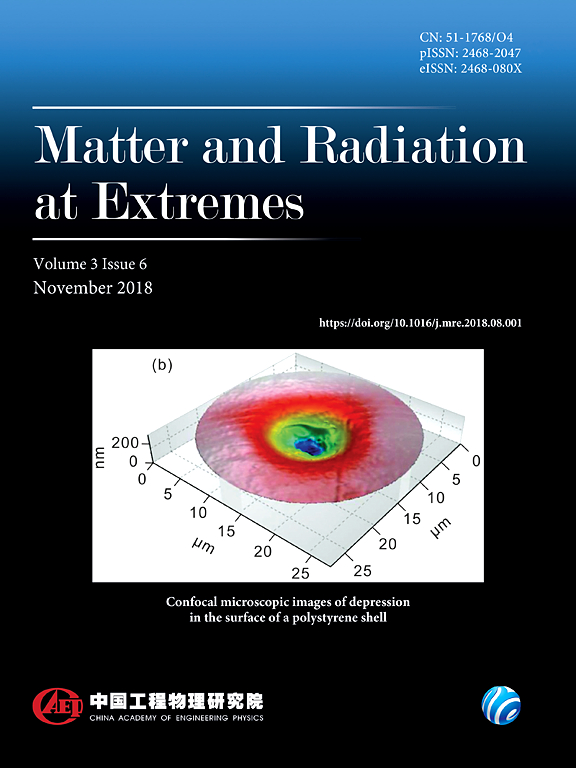Transition from backward to sideward stimulated Raman scattering with broadband lasers in plasmas
IF 4.7
1区 物理与天体物理
Q1 PHYSICS, MULTIDISCIPLINARY
引用次数: 0
Abstract
Broadband lasers have been proposed as future drivers of inertial confined fusion (ICF) to enhance the laser–target coupling efficiency via the mitigation of various parametric instabilities. The physical mechanisms involved have been explored recently, but are not yet fully understood. Here, stimulated Raman scattering (SRS) as one of the key parametric instabilities is investigated theoretically and numerically for a broadband laser propagating in homogeneous plasma in multidimensional geometry. The linear SRS growth rate is derived as a function of scattering angles for two monochromatic laser beams with a fixed frequency difference δω. If δω/ω0 ∼ 1%, with ω0 the laser frequency, these two laser beams may be decoupled in stimulating backward SRS while remaining coupled for sideward SRS at the laser intensities typical for ICF. Consequently, side-scattering may dominate over backward SRS for two-color laser light. This finding of SRS transition from backward to sideward SRS is then generalized for a broadband laser with a few-percent bandwidth. Particle-in-cell simulations demonstrate that with increasing laser bandwidth, the sideward SRS gradually becomes dominant over the backward SRS. Since sideward SRS is very efficient in producing harmful hot electrons, attention needs to be paid on this effect if ultra-broadband lasers are considered as next-generation ICF drivers.等离子体中宽带激光从向后到侧向受激拉曼散射的转变
宽带激光器已被提出作为惯性约束聚变(ICF)的未来驱动器,通过降低各种参数不稳定性来提高激光-目标耦合效率。所涉及的物理机制最近已被探索,但尚未完全理解。本文从理论上和数值上研究了宽带激光在多维均匀等离子体中传播的关键参数之一受激拉曼散射(SRS)。导出了两束固定频差δω的单色激光散射角的线性SRS增长速率。如果δω/ω0 ~ 1%,以ω0为激光频率,这两束激光在ICF典型的激光强度下可以在激发后向SRS时去耦,而在激发侧向SRS时保持耦合。因此,对于双色激光,侧散射可能占主导地位,而不是向后SRS。这一发现从向后的SRS到侧向的SRS的转变,然后推广到一个宽带激光与几个百分比的带宽。细胞内粒子模拟表明,随着激光带宽的增加,侧向SRS逐渐优于后向SRS。由于侧向SRS在产生有害热电子方面非常有效,因此如果超宽带激光器被认为是下一代ICF驱动器,则需要注意这种效应。
本文章由计算机程序翻译,如有差异,请以英文原文为准。
求助全文
约1分钟内获得全文
求助全文
来源期刊

Matter and Radiation at Extremes
Physics and Astronomy-Atomic and Molecular Physics, and Optics
CiteScore
8.60
自引率
9.80%
发文量
160
审稿时长
15 weeks
期刊介绍:
Matter and Radiation at Extremes (MRE), is committed to the publication of original and impactful research and review papers that address extreme states of matter and radiation, and the associated science and technology that are employed to produce and diagnose these conditions in the laboratory. Drivers, targets and diagnostics are included along with related numerical simulation and computational methods. It aims to provide a peer-reviewed platform for the international physics community and promote worldwide dissemination of the latest and impactful research in related fields.
 求助内容:
求助内容: 应助结果提醒方式:
应助结果提醒方式:


